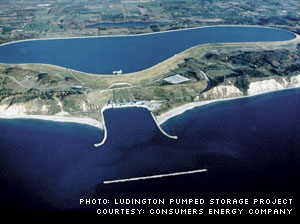Pumped storage projects move water between two reservoirs located at different elevations (i.e., an upper and lower reservoir) to store energy and generate electricity. Generally, when electricity demand is low (e.g., at night), excess electric generation capacity is used to pump water from the lower reservoir to the upper reservoir. When electricity demand is high, the stored water is released from the upper reservoir to the lower reservoir through a turbine to generate electricity. Pumped storage projects are also capable of providing a range of ancillary services to support the integration of renewable resources and the reliable and efficient functioning of the electric grid. View Diagram of a Pumped Storage Project.
The Commission has authorized a total of 24 pumped storage projects that are constructed and in operation, with a total installed capacity of over 16,500 megawatts. Most of these projects were authorized more than 30 years ago.
Existing and Proposed Projects
To view maps illustrating the location and capacity of existing and proposed pumped storage projects, see:
- Licensed Pumped Storage Projects Map updated 4/8/2025
- Pending Licenses and Relicenses for Pumped Storage Projects Map updated 4/8/2025
- Issued Preliminary Permits for Pumped Storage Projects Map updated 4/8/2025
- Pending Preliminary Permits for Pumped Storage Projects Map updated 4/10/2025
For information on specific pumped storage projects, including issued licenses and exemptions; pending licenses, relicenses, and exemptions; issued preliminary permits; and pending preliminary permits, see our main Licensing page.

